Wood remains one of the most versatile and timeless materials in interior design, offering endless possibilities for creating warm, inviting spaces. Current trends show a strong movement toward warmer wood tones, with oak, walnut, and cherry gaining popularity for their natural beauty and distinctive grain patterns. Design professionals are embracing darker woods like walnut for their refined richness and depth, while wood paneled walls and handcrafted wooden furniture are becoming essential elements of contemporary interiors. Whether you're drawn to minimalist Scandinavian aesthetics or prefer bold rustic charm, wooden elements can transform any space into a sophisticated sanctuary that celebrates natural beauty and craftsmanship.

1. Modern Rustic Living Room with Reclaimed Wood Features

Modern rustic design merges clean contemporary lines with authentic natural textures, creating spaces that feel both sophisticated and welcoming. This design approach incorporates reclaimed wood furniture as focal points, paired with minimalist metal chairs and sleek glass coffee tables. Exposed wooden beams in ceilings deliver authentic rustic charm while maintaining contemporary appeal. The color palette centers on neutral tones like beige, taupe, and soft grays, allowing the natural wood grain to take center stage. Textured fabrics like linen and leather in upholstery enhance the simple vibe while keeping things modern. This style celebrates imperfections in natural materials, embracing their authentic beauty while incorporating minimalist principles for refined ambiance.
2. Japandi Bedroom with Natural Wood Tones

Japandi style combines functional Scandinavian design with Japanese minimalism, emphasizing clean lines and natural materials. The bedroom features light wooden furniture with simple cushions and organic shapes that promote tranquility. Natural wood provides tactile connection while maintaining the Japanese wabi-sabi philosophy of finding beauty in imperfection. Wall colors remain neutral in soft beiges and off-whites, with furniture crafted from bamboo, rattan, or natural wood showcasing visible grain patterns. Floor beds or low-profile wooden frames create harmony with nature-inspired elements. Houseplants and greenery align with biophilia principles, adding vitality while maintaining the minimalist aesthetic. Subtle geometric patterns in textiles provide gentle contrast without overwhelming the serene atmosphere.
3. Scandinavian Kitchen with Light Wood Cabinetry
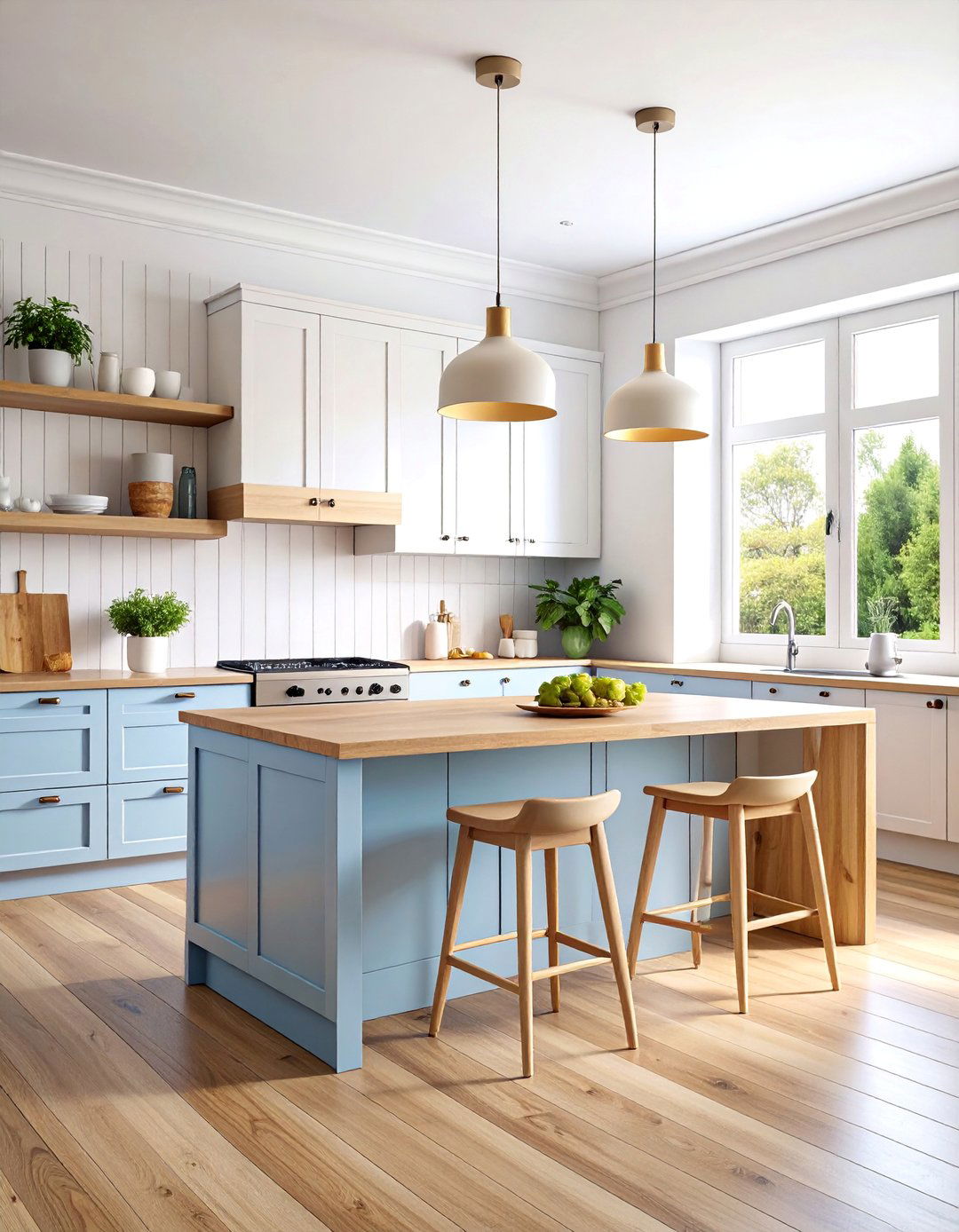
Scandinavian design emphasizes functionality using light woods like oak, ash, maple, and birch with natural varnishes. Kitchen cabinets feature clean, simple lines in pale wood tones that maximize natural light reflection. Kitchens are shifting from cooler whites to warmer off-whites and taupes, creating more inviting atmospheres. Butcher block or reclaimed wood kitchen islands provide functional centerpieces that add warmth to sleek countertops. Open shelving displays ceramic dishware and glassware in organized, minimalist arrangements. Hardware remains understated in brushed metal finishes. The design prioritizes natural light through large windows and maintains uncluttered surfaces. Color schemes incorporate soft blues and greens alongside natural wood tones for calming, cohesive aesthetics.
4. Industrial Wooden Accent Wall Design
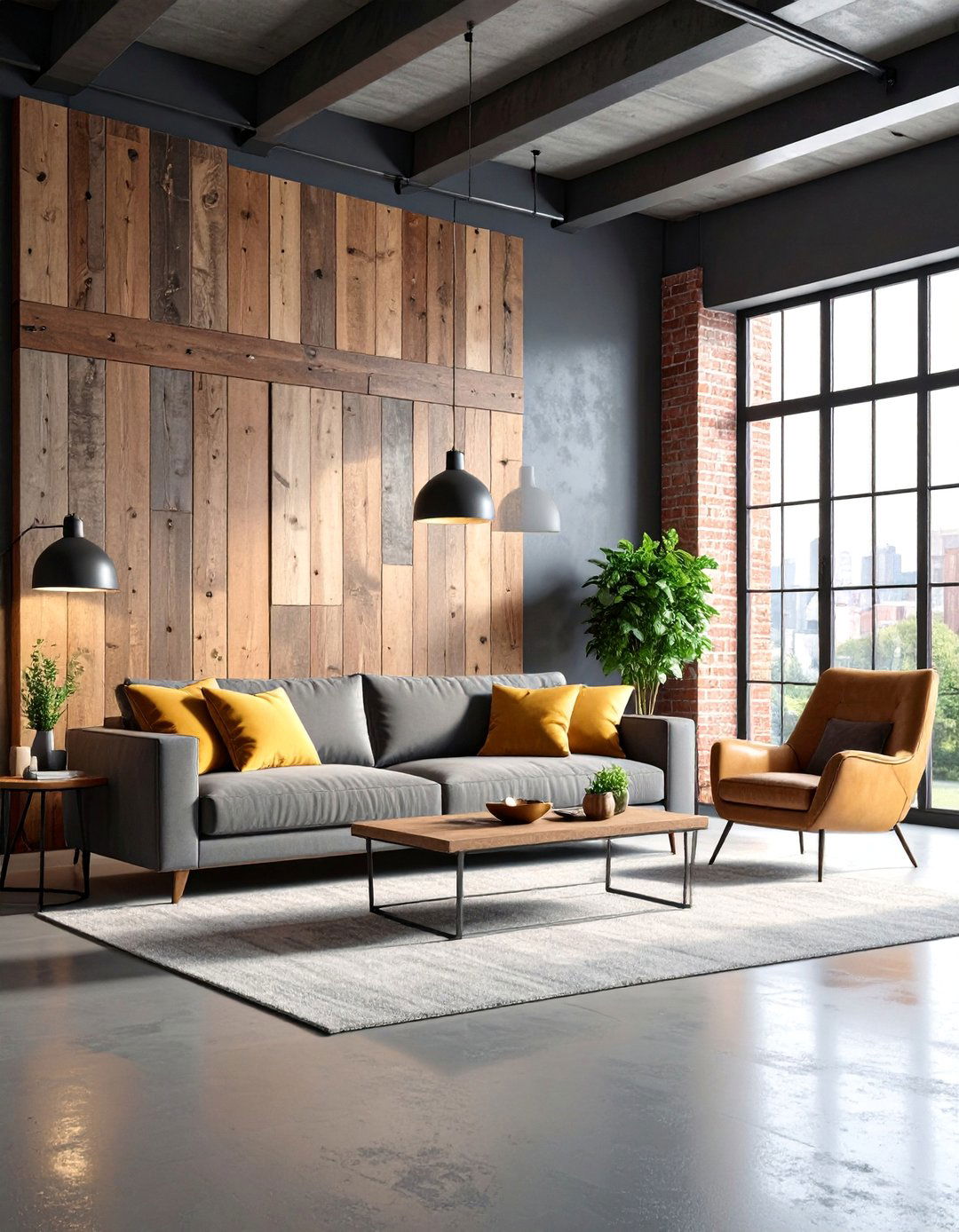
Wood accent walls transform spaces by adding natural texture and color, drawing the eye immediately upon entering. Industrial design pairs raw wooden planks with exposed brick, steel beams, and concrete elements for bold contrast. Industrial-style wooden houses complement structures with exposed brick and steel, creating striking architectural statements. Reclaimed barn wood paneling brings rustic appeal while supporting environmental sustainability through recycling. Metal accents in lighting fixtures and hardware enhance the industrial aesthetic. Color palettes feature charcoal grays, deep browns, and black metal finishes. Different wood products can create mixed wood accent walls for one-of-a-kind artistic looks. This approach works exceptionally well in lofts, studios, and modern commercial spaces seeking authentic character.
5. Floating Wood Shelves in Minimalist Settings
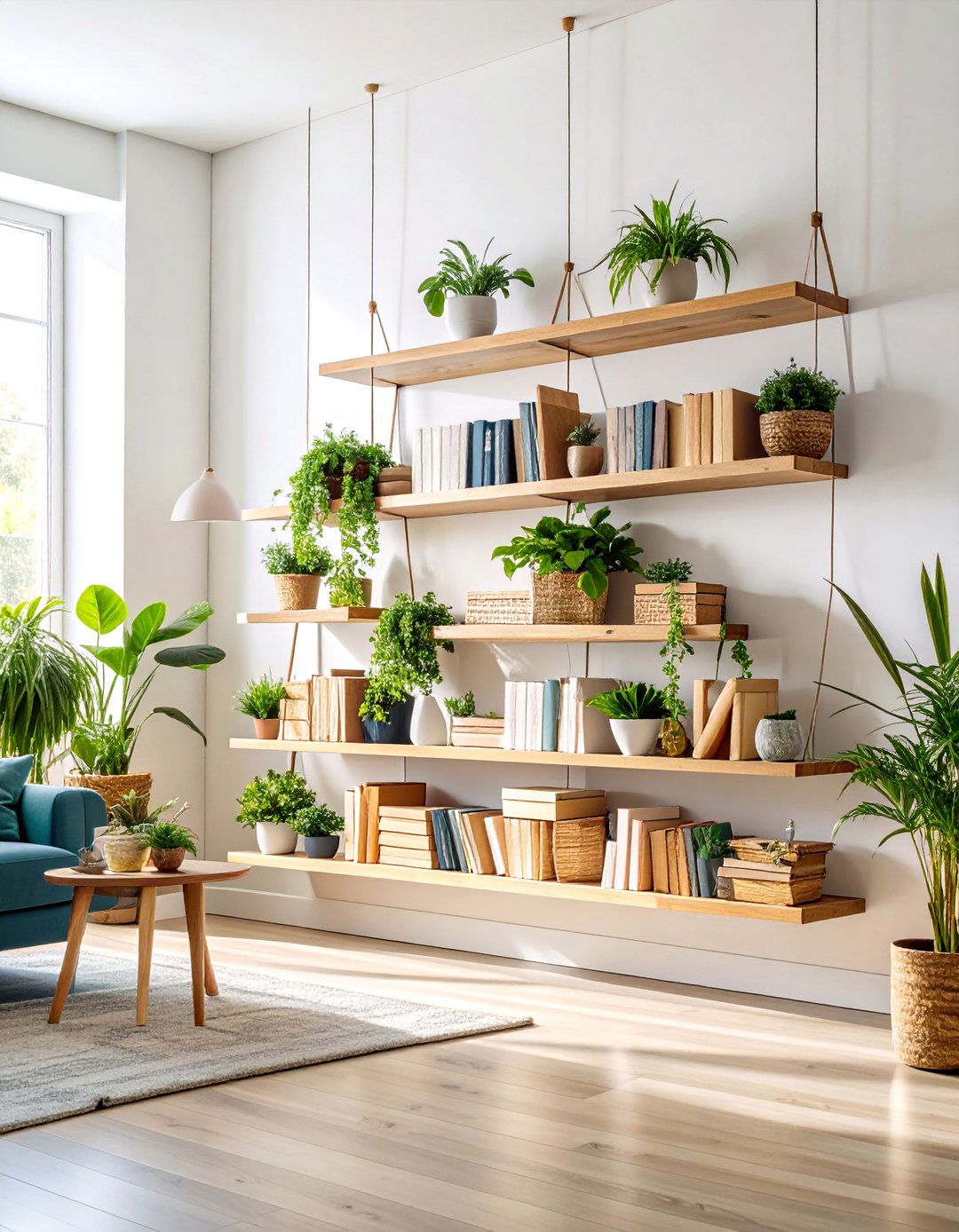
Floating shelves made from reclaimed wood or raw-edge timber merge functionality with farmhouse elements for contemporary design. These installations appear to defy gravity, creating clean lines without visible hardware disrupting the aesthetic. Minimalist interiors benefit from wooden elements that add warmth while maintaining architectural simplicity. Natural wood grain provides organic texture against white or neutral walls. Display arrangements follow the rule of threes, incorporating books, plants, and decorative objects in balanced compositions. Open shelving allows favorite pieces to remain visible while hiding clutter in lower cabinets. Installation requires careful consideration of wall structure and weight distribution. Wooden accents like floating shelves enhance room design without overwhelming minimalist principles. Strategic lighting underneath creates ambient illumination.
6. Exposed Wooden Beam Ceiling Treatment
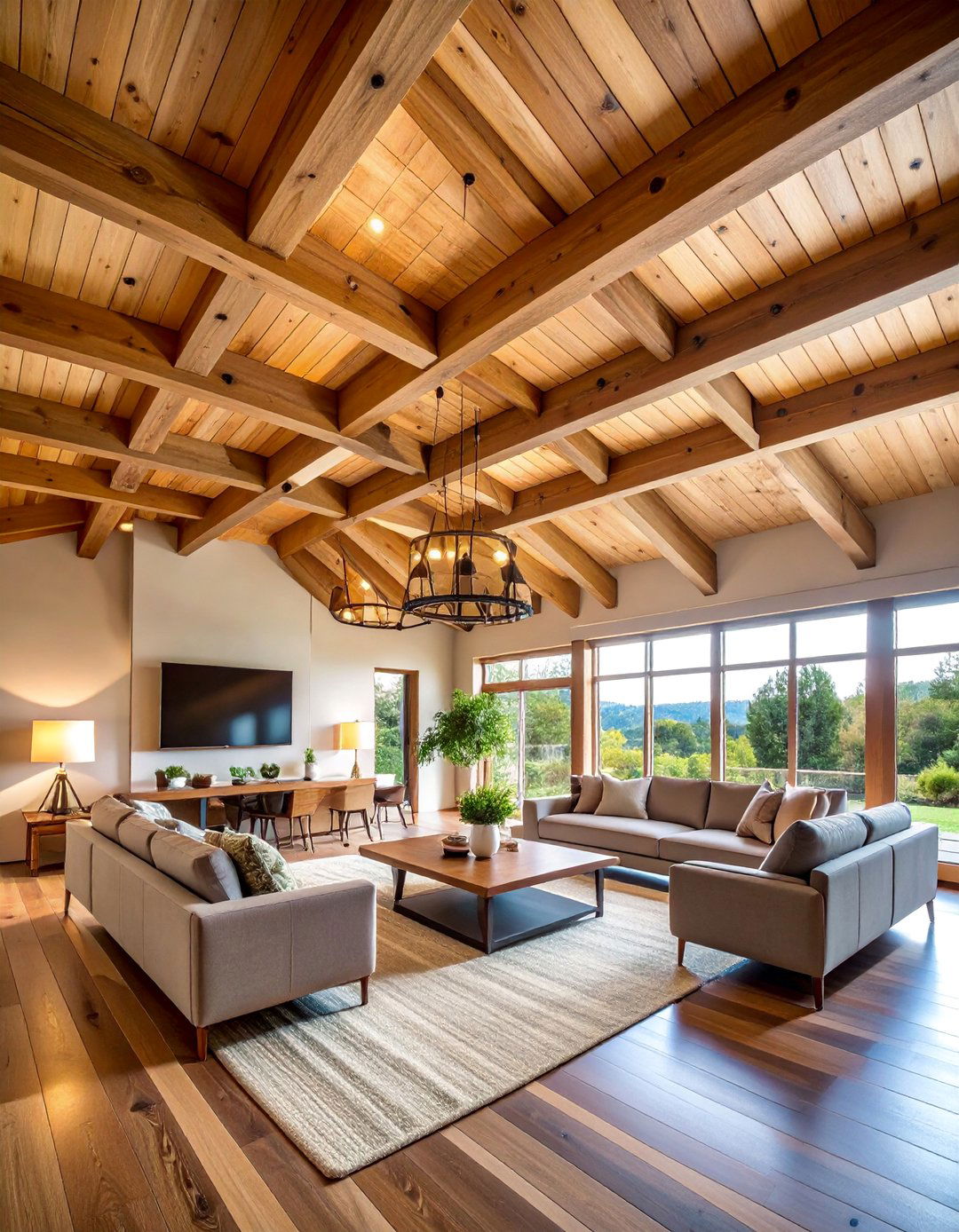
Exposed beams create cozy atmospheres while adding natural texture and warmth to any room. Wooden beams exude rustic elegance, evoking authenticity and natural beauty as focal points. Installation options include flat mounting against painted surfaces or bridging across vaulted ceilings. Wood beams offer functional benefits by concealing mechanical, electrical, and plumbing components. Traditional materials like butternut and mahogany showcase beautiful natural grain patterns. Beams can remain natural for authentic rustic appeal or be painted to match ceiling colors for sophisticated appearances. Multiple layers of beams with wood planks create timeless, unforgettable architectural designs. Faux wood beams provide lighter alternatives with simpler installation while achieving the same visual impact.
7. Wood Wainscoting for Traditional Elegance
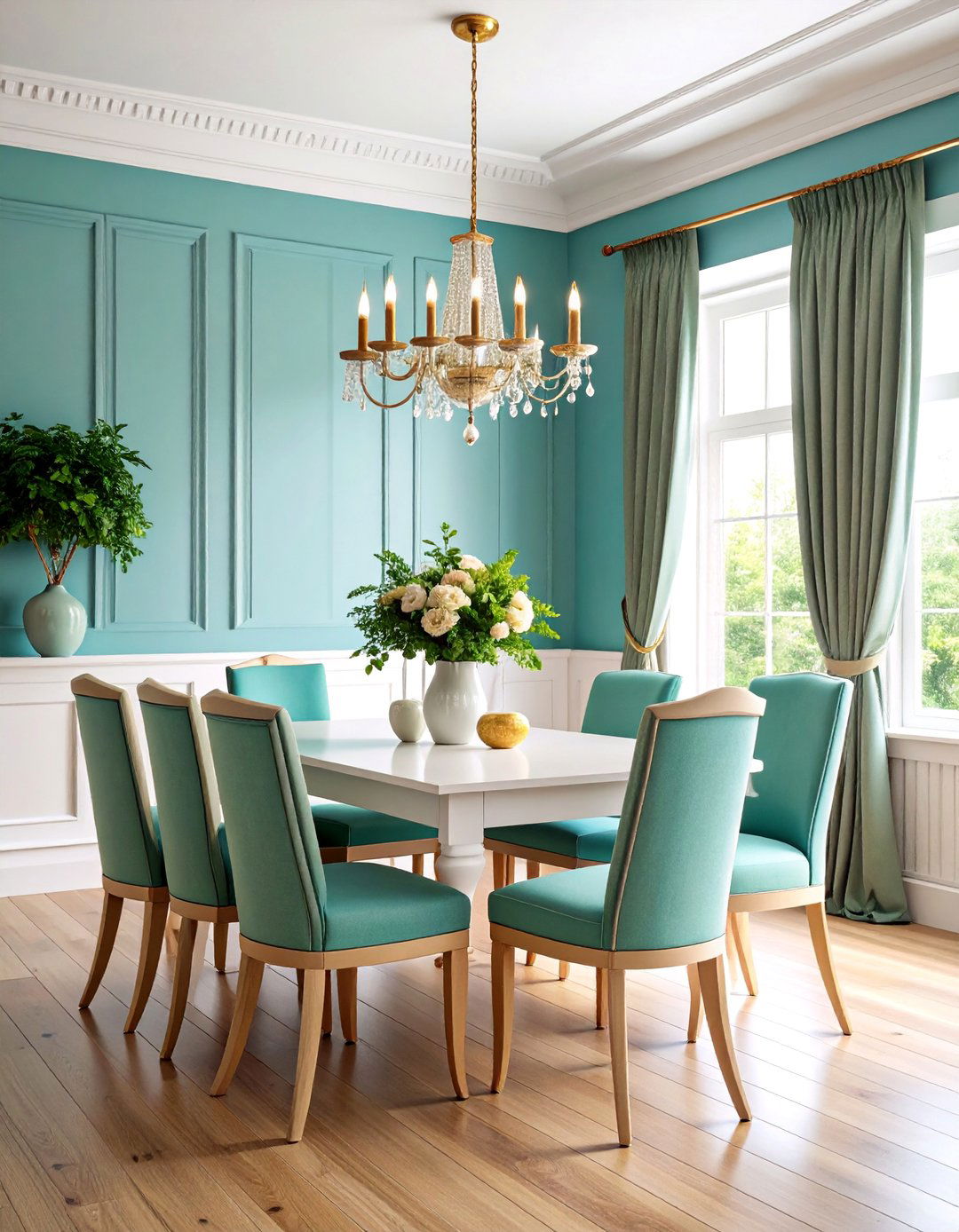
Wainscoting, particularly beadboard, ranks among the hottest interior design trends, replacing shiplap in popularity. Board and batten walls create classic design elements with architectural interest and refined structure. Traditional installation covers the lower half of walls, protecting surfaces from wear while adding decorative appeal. Beadboard can be used in traditional wainscoting style or extended to full accent walls. Paint colors range from classic whites to sophisticated dark hues that complement existing decor. Natural wood versions celebrate craftsmanship and bring authentic character to modern spaces. Installation requires careful measurement and proper wall preparation. Vertical or horizontal orientations offer different visual effects, with vertical slats adding modern warmth. Crown molding and baseboard details complete the elegant appearance.
8. Fluted Wood Panel Feature Wall
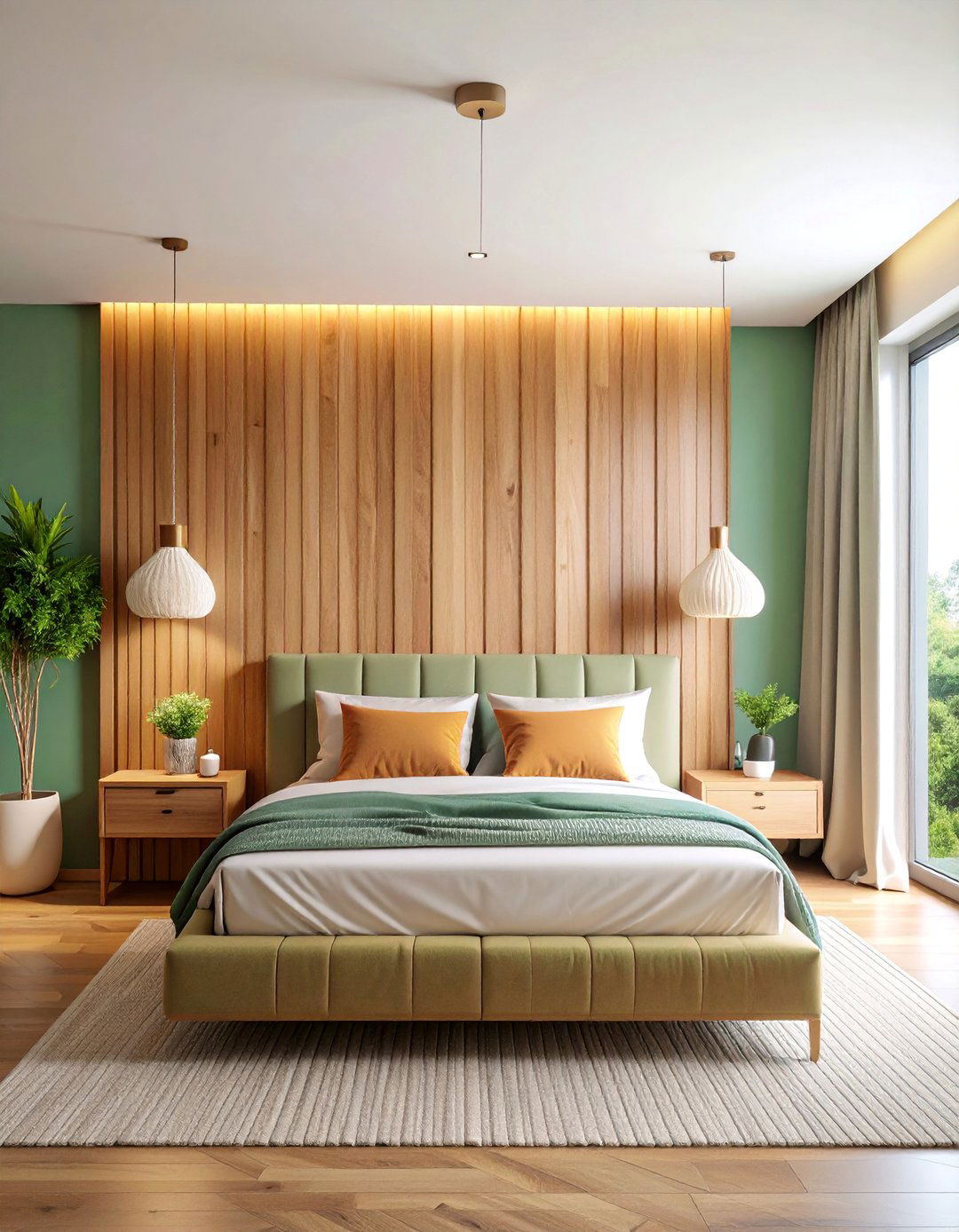
Fluted accents are appearing everywhere in wall coverings and cabinetry, offering simple yet striking texture over color. These linear elements create sophisticated visual interest through repetitive vertical patterns. Fluting's understated curved features support minimalist design while adding aesthetic appeal unobtrusively. Installation involves evenly spaced wooden slats mounted over backing material for consistent appearance. Natural wood finishes highlight grain patterns, while painted versions offer color customization. Slatted wall panels provide soundproofing benefits, making them ideal for home offices and bedrooms. Vertical slats of wood add modern warmth and draw curious attention from any room corner. Lighting integration behind panels creates dramatic shadow effects. This design works particularly well behind beds, in dining rooms, or as lobby features.
9. Built-in Wooden Storage Solutions
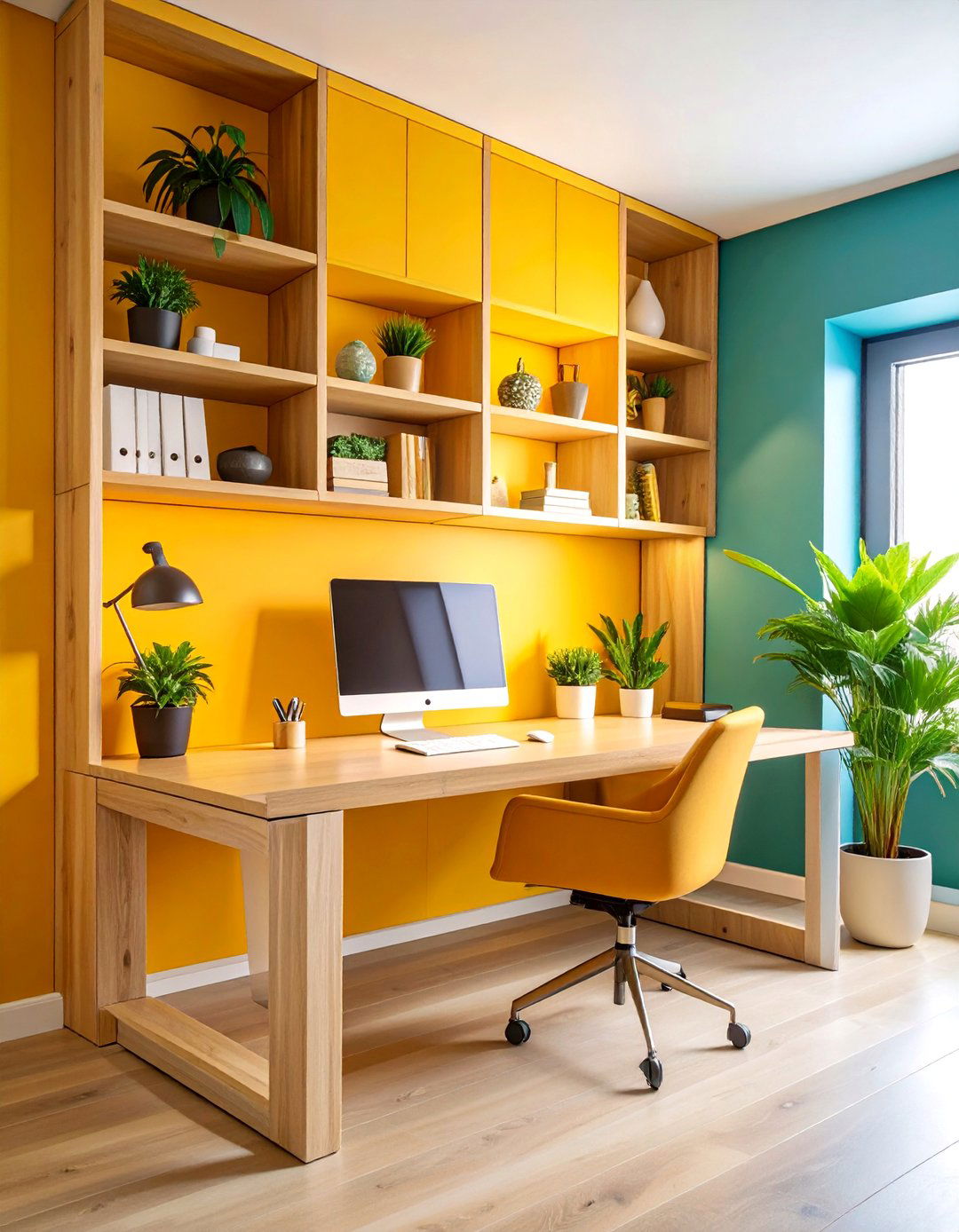
Custom built-ins maximize space by fitting perfectly into specific areas, particularly helpful in small or awkwardly shaped rooms. These installations provide extra storage while maintaining organized, clutter-free environments. Unfinished stock kitchen cabinets can create custom-looking built-ins at affordable prices. Components include pullout drawers, adjustable shelves, TV openings, and glass doors for comprehensive functionality. Custom built-ins add significant home value and attract buyers seeking practical storage solutions. Wood species selection affects both appearance and durability, with oak and maple offering excellent longevity. Floating shelves can replace upper cabinets to create more open, breathable spaces. Dining room built-ins house seasonal dishware and overspill from kitchens effectively.
10. Dark Walnut Modern Furniture Suite

Walnut woodgrains in darker, dramatic tones are emerging as key trends, adding luxurious and modern touches to interiors. While neutral decor has been popular, darker woods like walnut bring warmth and depth with refined richness. Modern walnut furniture features clean lines and geometric shapes that emphasize the wood's natural beauty. Deep walnut richness adds coziness and sophistication to living spaces. Furniture pieces include dining tables, coffee tables, credenzas, and bedroom sets in matching wood tones. Rustic furniture pieces like wooden dining tables pair beautifully with modern metal chairs. Hardware selection in brushed brass or black metal complements the dark wood finish. Quality craftsmanship ensures these pieces become long-term investments in home decor.
11. Shiplap Wood Wall Cottage Style
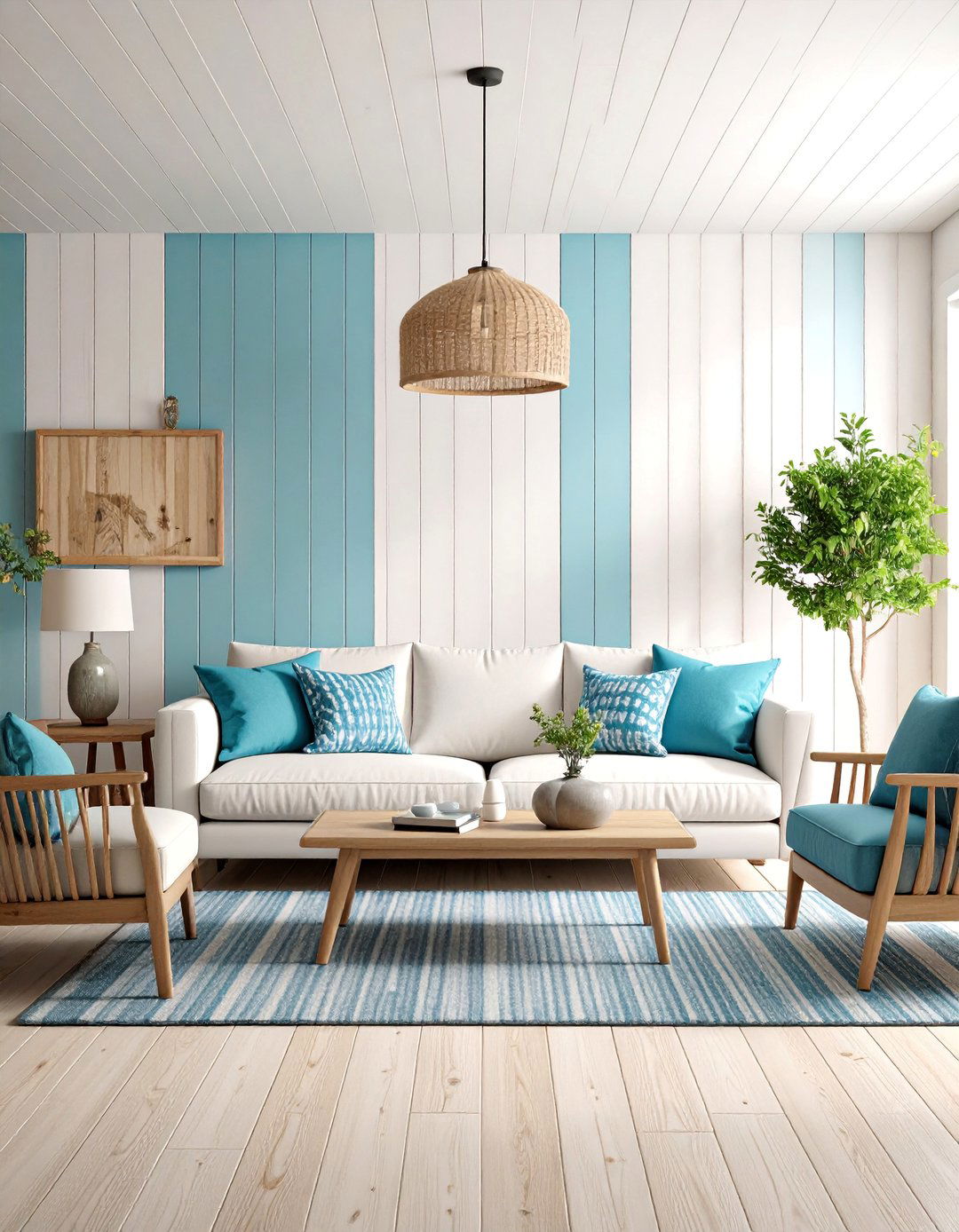
Shiplap ceilings and walls bring warmth and character to spaces, creating cozy, rustic vibes associated with coastal cottages. Horizontal wooden planks install with overlapping edges for seamless coverage and traditional maritime appearance. While less popular than previously, shiplap maintains appeal in farmhouse and cottage core aesthetics. Paint finishes range from classic white to weathered grays and soft pastels that enhance coastal themes. These wooden planks arrange horizontally or vertically across walls to create intimate, charming atmospheres. Installation requires proper wall preparation and consistent spacing for professional results. Cottage-style wooden homes feature decorative woodwork that evokes warmth and countryside comfort. Tongue and groove installation creates uniform looks while simplifying the construction process.
12. Wooden Ceiling Planks for Warmth
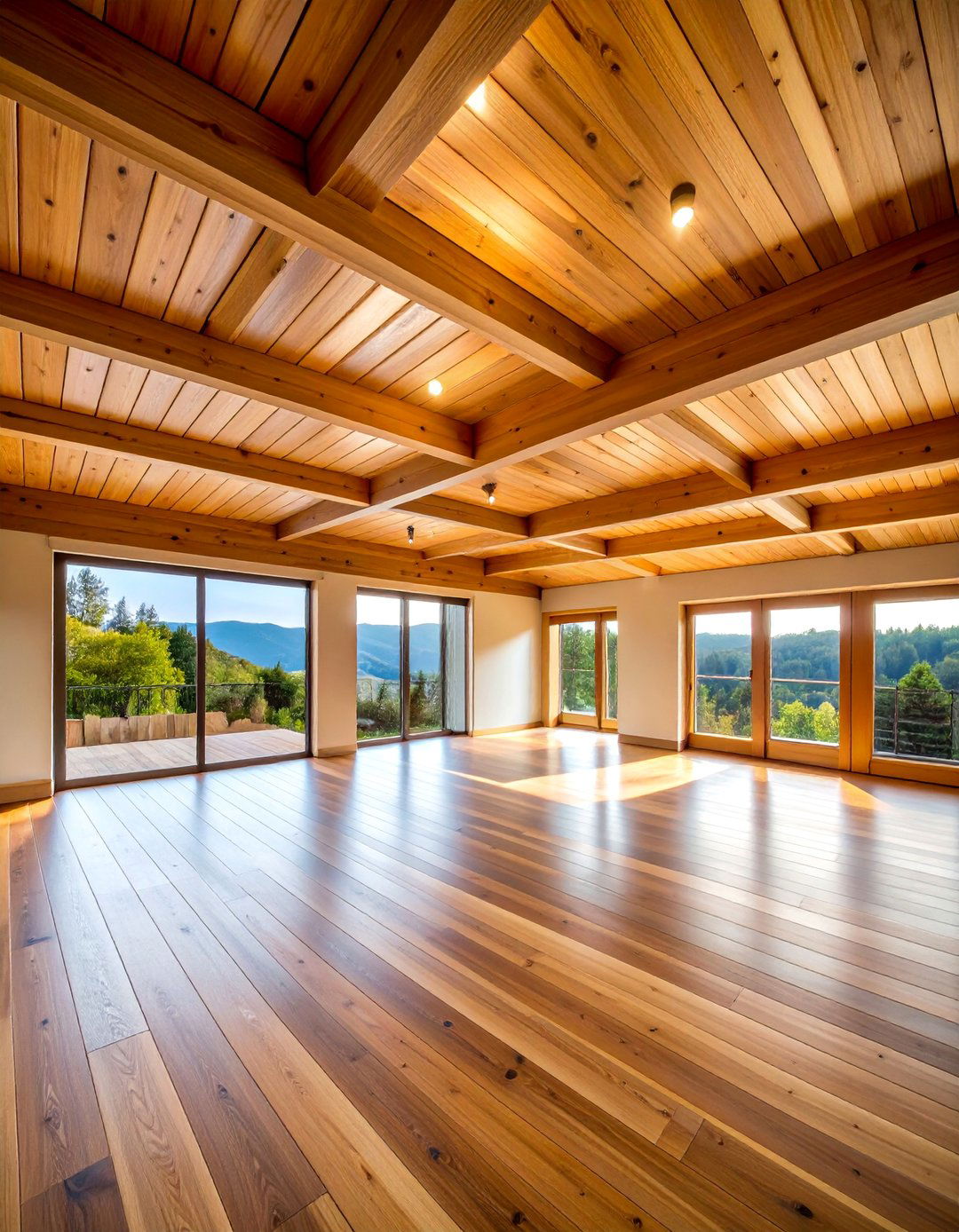
Wood ceiling planks are eye-catching additions that expand visual appeal by adding texture and color from above. Mellow wood grain envelops serene spaces, creating atmospheric environments with natural warmth. Whitewashed barn wood paneling draws eyes upward, making ceilings interesting focal points often overlooked in remodeling. Most applications utilize tongue and groove or shiplap paneling for uniform appearance and smooth installation. Wood planks can arrange horizontally or vertically to create different visual effects. Natural finishes celebrate authentic wood grain, while painted versions coordinate with existing color schemes. Vaulted and barrel ceilings are perfect locations for wooden treatments that add depth and architectural interest. Proper structural support ensures safe installation of heavier materials.
13. Live Edge Wood Dining Table Setup
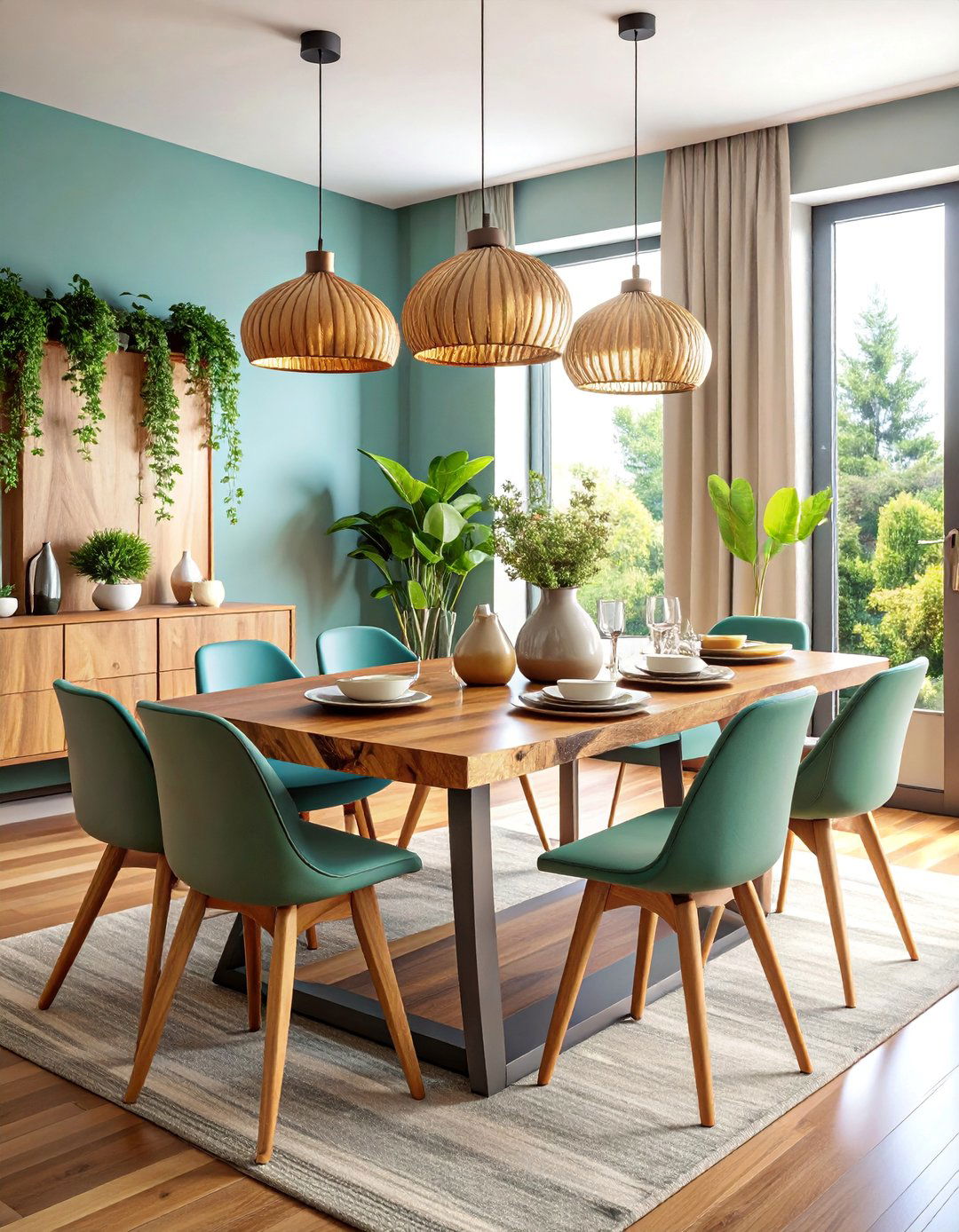
Live edge furniture celebrates natural wood forms by preserving the original tree shape along one or more edges. These unique pieces showcase organic beauty with irregular curves and natural imperfections that make each table one-of-a-kind. Raw, organic elements like natural wood emphasize minimalist design while maintaining authentic character. Japanese wabi-sabi philosophy appreciates imperfection and impermanence, reflected in handmade elements. Dining room setups pair live edge tables with modern chairs to balance rustic and contemporary elements. Wood species like walnut, cherry, and oak offer different grain patterns and color variations. Metal table legs create striking contrast with natural wood tops. Regular maintenance preserves the natural finish and prevents damage. These statement pieces serve as conversation starters while providing functional dining surfaces.
14. Wooden Room Dividers for Open Spaces
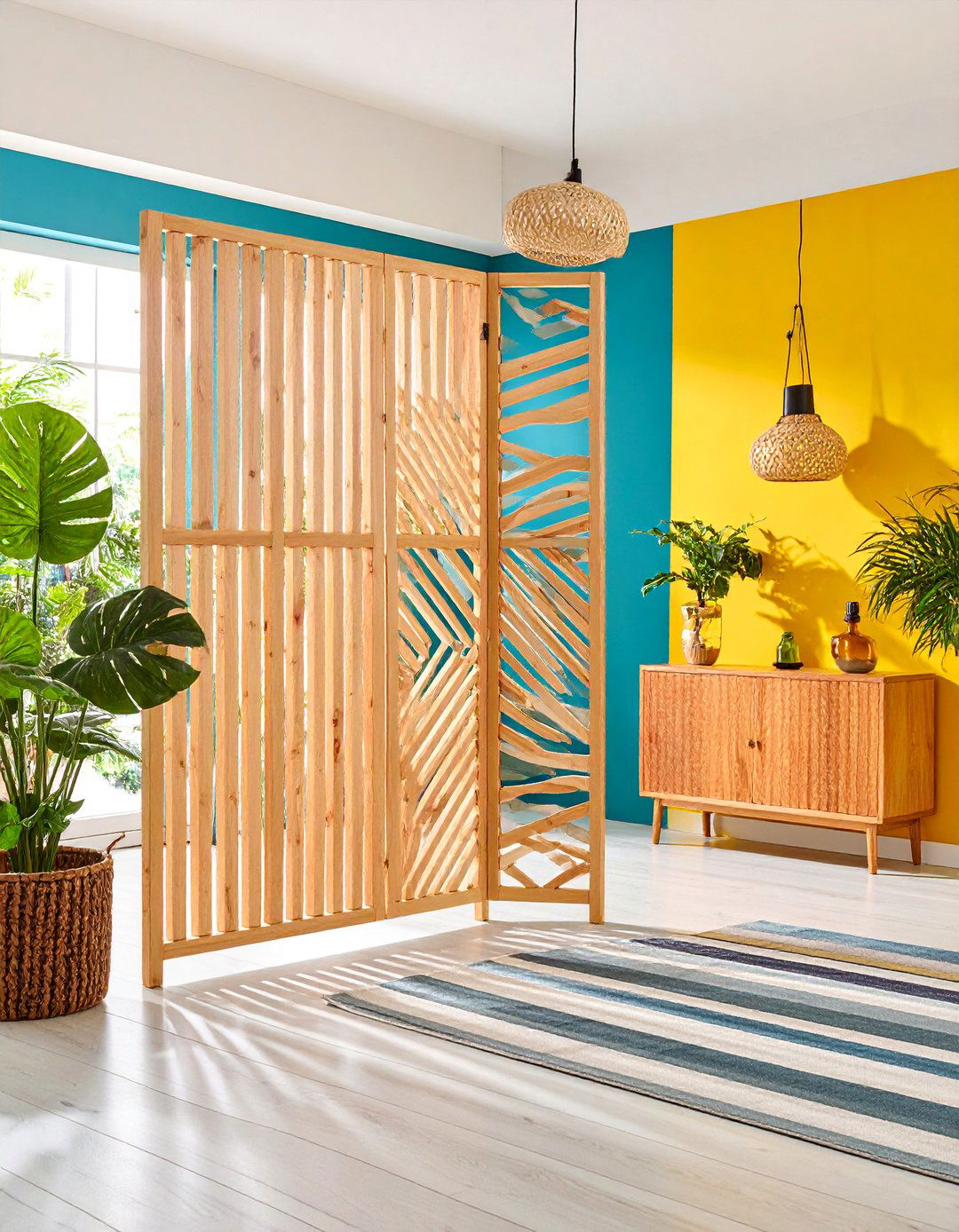
Large open designs benefit from wooden ceiling treatments that bring definition without limiting sight lines with walls. Wooden room dividers create spatial separation while maintaining visual connection between areas. Japanese style interiors use sliding doors and screens known as shoji for flexible space division. Modern interpretations feature vertical slats or geometric patterns that filter light while providing privacy. Curved wooden fascias wrap corners to fashion attractive storage areas and spatial transitions. Installation options include floor-to-ceiling mounting or partial height dividers that define zones. Skilled craftsmanship in joinery techniques creates seamless connections between wooden elements. Natural wood finishes complement various decor styles, while painted versions offer color coordination. Clean lines and sparse arrangements maintain functionality while adding architectural interest.
15. Custom Wood Kitchen Island Design
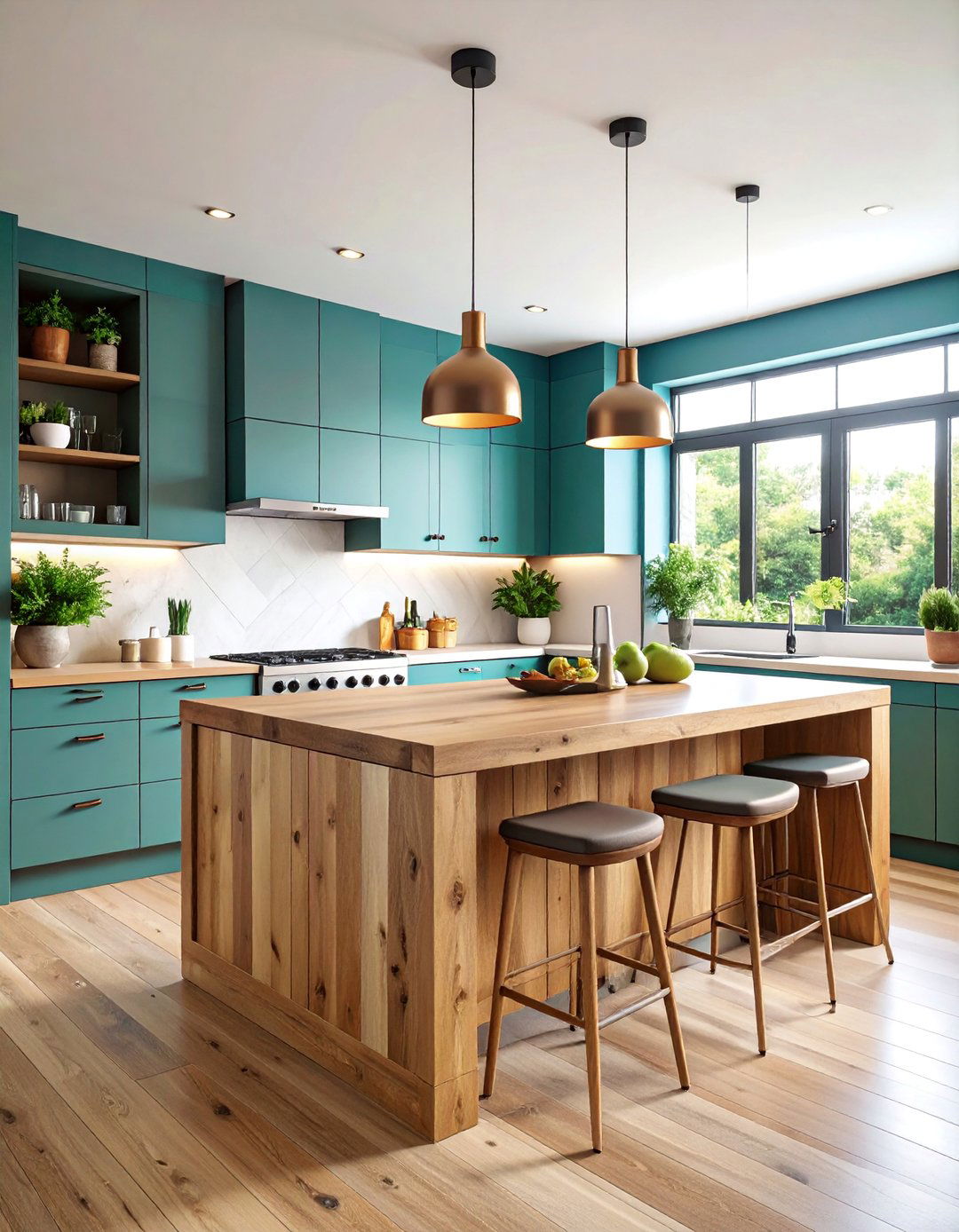
Kitchen islands made from reclaimed wood or butcher block provide functional centerpieces that add warmth contrasting with sleek countertops and cabinetry. Custom islands incorporate storage drawers, wine racks, and specialized compartments for kitchen tools. Solid walnut cabinets below islands bring beautiful warmth to kitchen designs. Kitchen peninsulas double as breakfast bars, maximizing functionality in compact spaces. Wood species selection affects durability and appearance, with harder woods like oak and maple resisting daily wear. Marine-grade wood treatments provide better water resistance than standard butcher block finishes. Seating integration requires careful height consideration for comfortable dining. Light wood islands paired with pendant lighting create cohesive design statements. Regular maintenance preserves wood surfaces in high-use kitchen environments.
16. Timber Frame Accent Architecture

Wooden houses blend contemporary design with natural warmth, featuring wood as primary structural and aesthetic material. Timber framing creates dramatic architectural statements through exposed structural elements that combine function with visual impact. Layered beam systems with first and second level supports create timeless, unforgettable design features. Japanese and Nordic joinery techniques demonstrate skilled craftsmanship in half-lap and mortise connections. Modern applications integrate steel connections for enhanced structural performance while maintaining traditional aesthetics. Minimalist interiors emphasize clean lines and functional design elements that promote calm and order. Wood treatment options include natural stains that highlight grain patterns or painted finishes for color coordination. Solid wood beams showcase beautiful grain patterns in butternut and mahogany species.
17. Wood and Stone Fireplace Surround
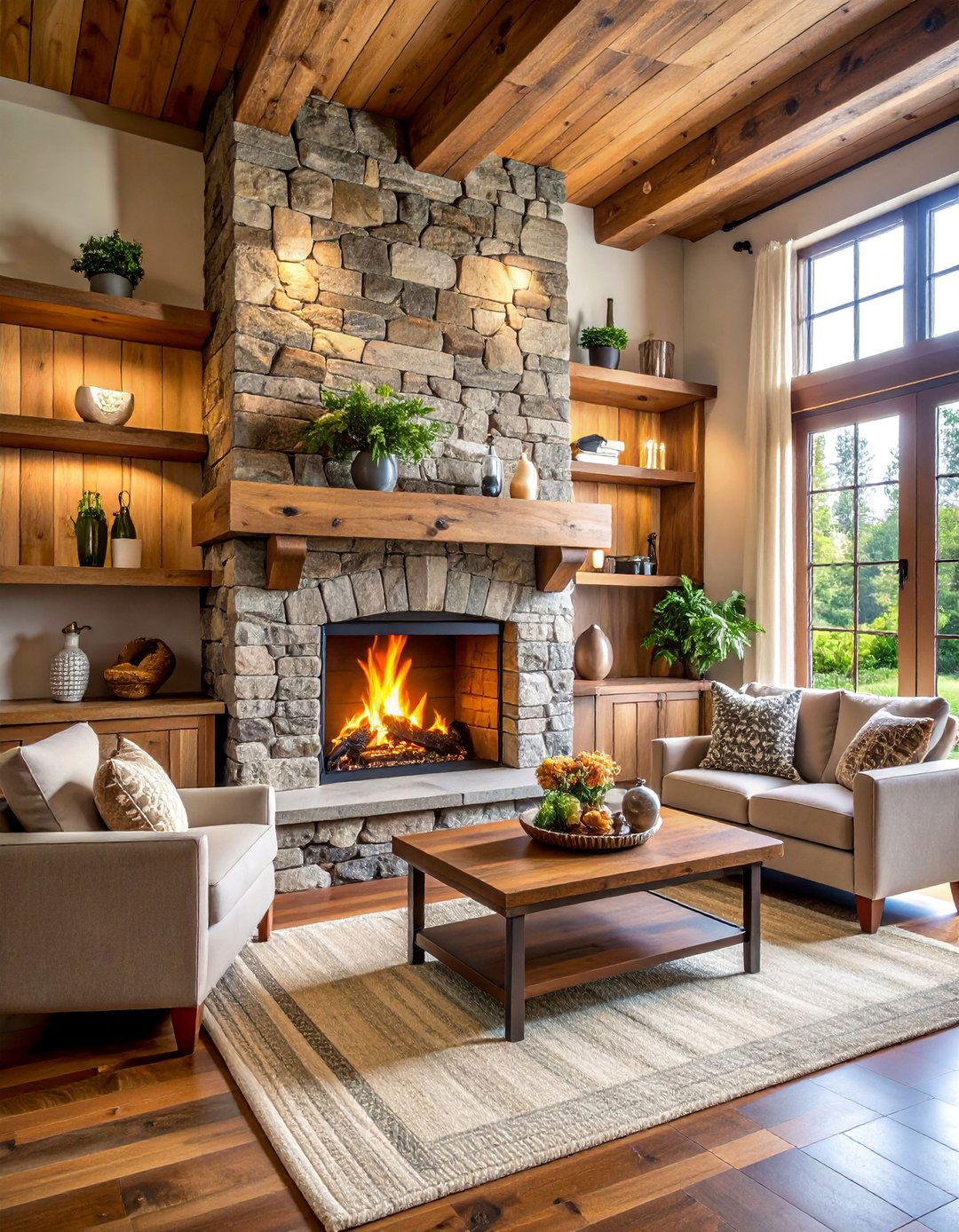
Floor-to-ceiling stone fireplaces serve as perfect centerpieces for rustic living rooms, enhanced with wooden mantels. Custom wood fireplace surrounds include open shelves and striking floor-to-ceiling firewood storage nooks. Natural material combinations create focal points that anchor room designs while providing functional heating elements. Modern fireplaces warm large living rooms from underneath curvaceous chimney breasts. Wood species selection affects both durability and appearance near heat sources, requiring proper treatment and clearances. Reclaimed wood mantels coordinate with wood shelves displaying decorative objects. Brass sconces provide library-like touches while custom frames make televisions appear picture-perfect above mantels. Rustic accents including wooden furniture and beams introduce casual warmth to sophisticated spaces.
18. Herringbone Wood Floor Feature
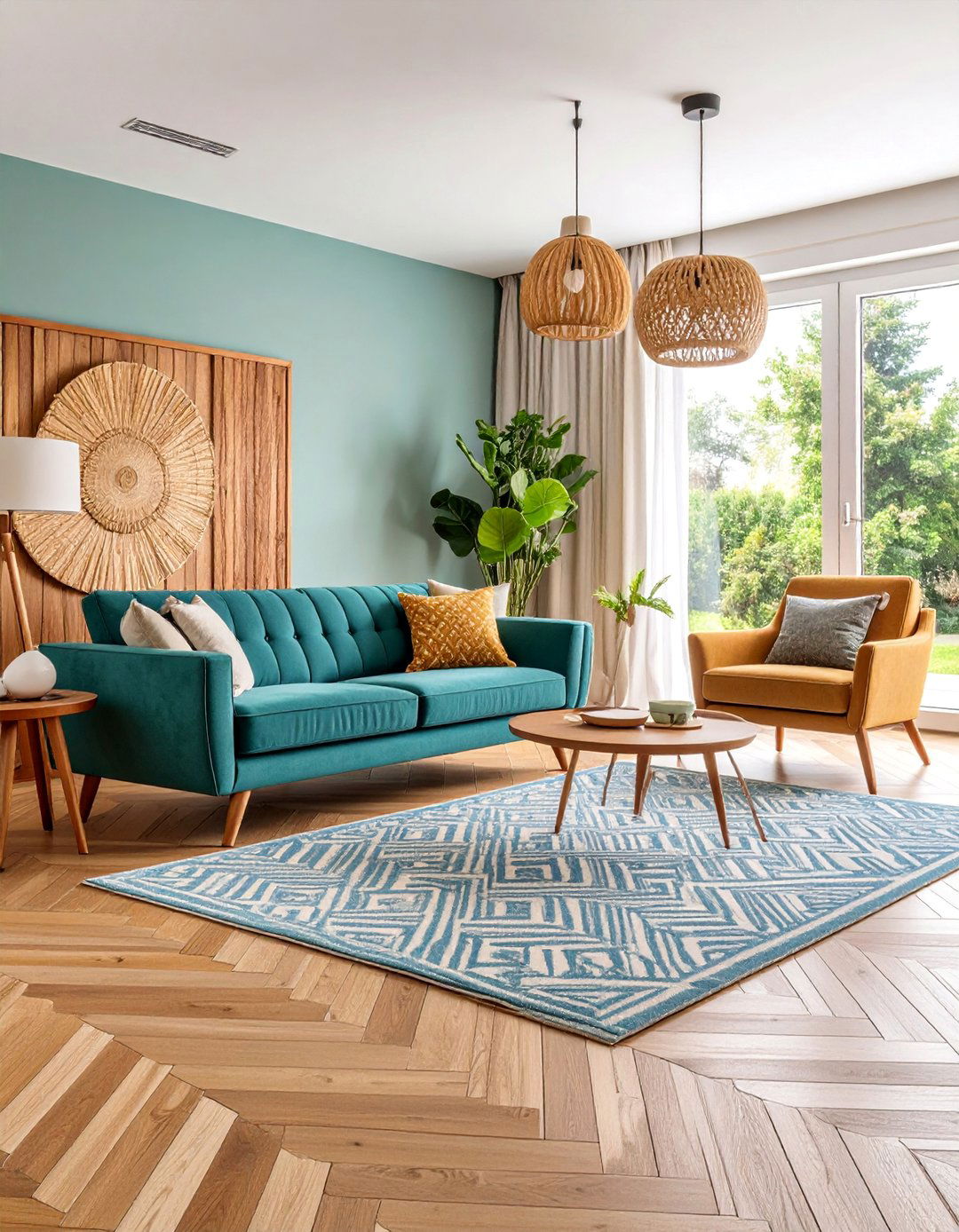
Herringbone wood accent walls using dark and light planks of hickory and white oak create stunning visual patterns. Floor applications extend this classic pattern throughout living spaces for sophisticated geometric appeal. Flooring materials used on walls create unique and innovative design approaches. Installation requires precise cutting and fitting to achieve consistent zigzag patterns that draw the eye across surfaces. Light woods with warm undertones continue demanded for minimalist-leaning designs. Muted greens, earthy browns, and subtle charcoal accents complement natural wood herringbone patterns. Professional installation ensures proper expansion gaps and subflooring preparation for longevity. Modern twists on classic patterns opt for vertical or horizontal orientations in wainscoting applications. Maintenance requires appropriate wood floor cleaners and periodic refinishing.
19. Wooden Built-in Bench Seating
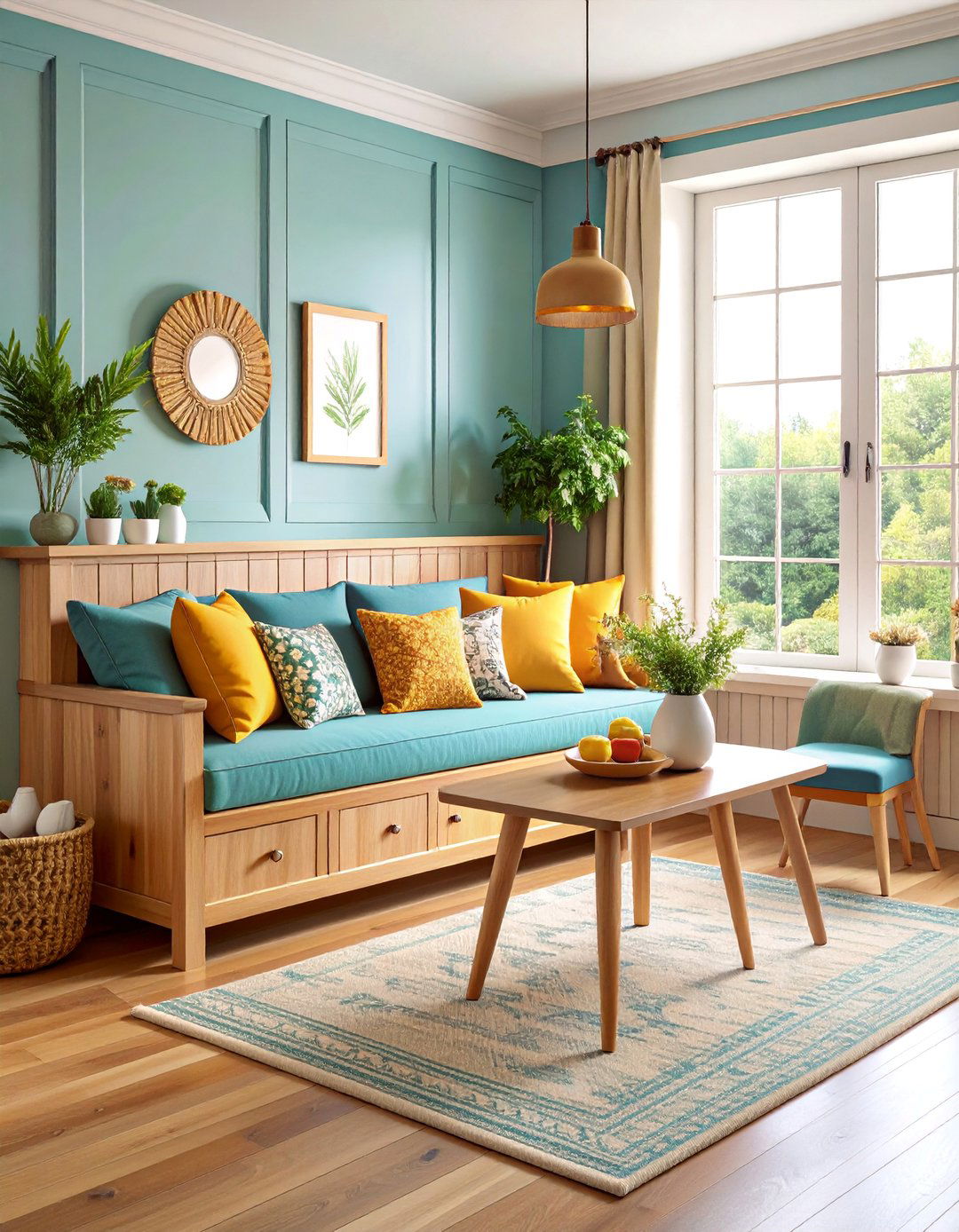
Built-in bench seating provides both fashionable and functional solutions for dining rooms and nooks. Window seats with storage compartments maximize space utilization while creating cozy reading areas. Built-in benches incorporate storage underneath for seasonal items and household organization. Cushion integration requires consideration of fabric durability and cleaning requirements for high-use seating. Plaid cushions on rustic wooden daybeds create cozy spots for lake views and relaxation. Black on wood breakfast nooks with matching floor-to-ceiling cabinets create sophisticated dining environments. Installation involves careful measurement of available space and proper wall anchoring for safety. Base cabinets can be modified to create custom seating solutions with integrated storage. Upholstery options range from leather to fabric depending on room style.
20. Mid-Century Modern Wood Furniture

Mid-century modern merges with 60s-80s influences, creating timeless fusion that bridges past and present. Furniture features characteristic tapered legs, clean lines, and organic curves that defined the era's aesthetic philosophy. Pierre Jeanneret's Easy chairs demonstrate classic mid-century wooden dining seating. Danish design emphasizes foldable functionality combined with Japanese simplicity in fiber usage. Wood species typically include teak, walnut, and rosewood with natural oil finishes that highlight grain patterns. Norm Architects designed furniture together with Japanese manufacturer Karimoku, showcasing cultural design fusion. Sculptural furniture and retro lighting combine with bold patterns for authentic period appeal. Authentic pieces command premium prices, while quality reproductions offer accessible alternatives. Functionality remains paramount without compromising aesthetic beauty.
21. Rustic Wood Bathroom Vanity Design
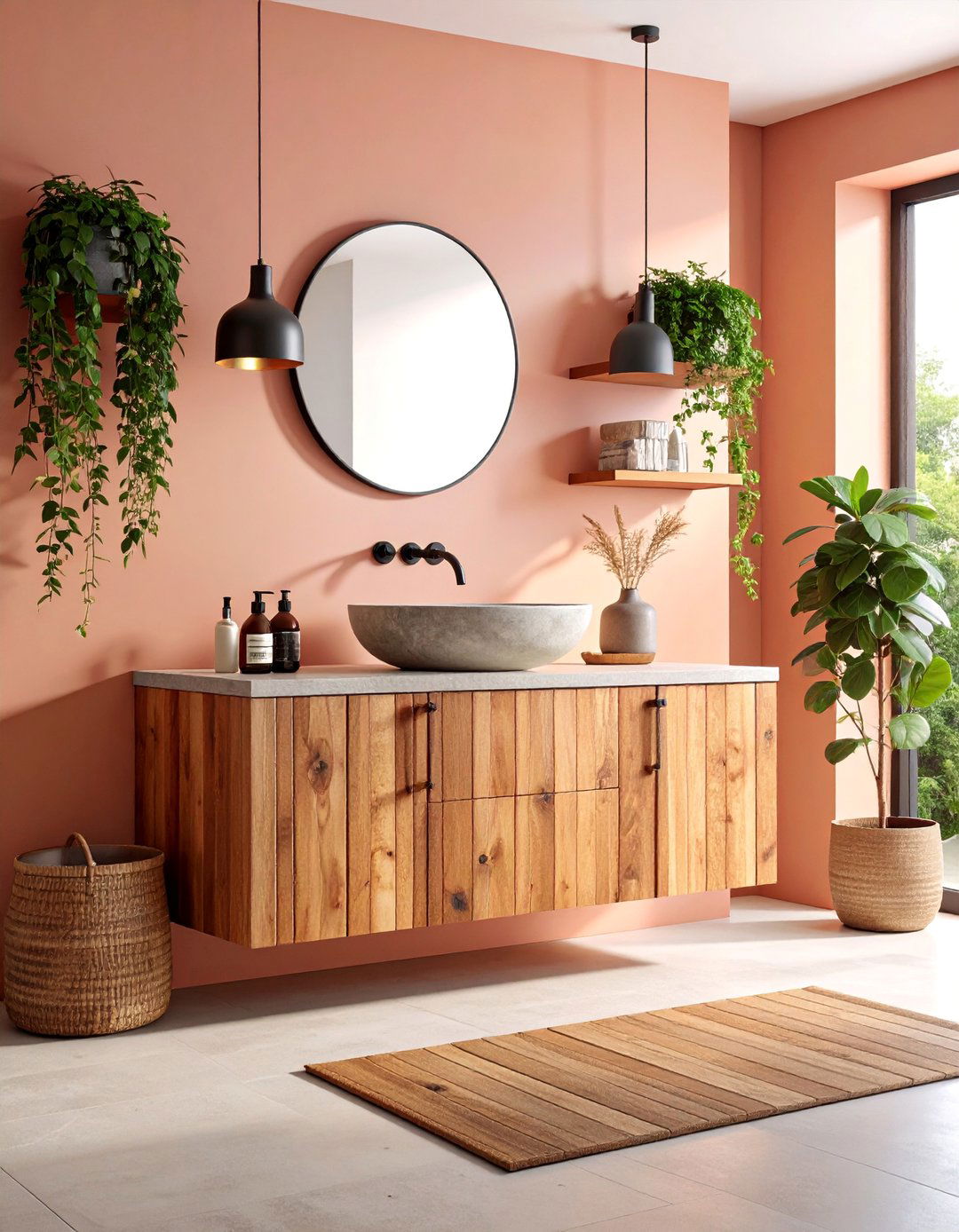
Stone sinks and wooden vanities set earthy tones in bathrooms, offering grounded, natural feels. Farmhouse-style sinks emerge with natural wood replacing typical vanities, accentuated by exposed industrial pipes. Reclaimed wood construction provides authentic character while supporting environmental sustainability through material reuse. Marine-grade wood finishes resist bathroom moisture better than standard treatments. Modern fixtures like chrome faucets add sophistication while maintaining functional simplicity. Storage integration includes drawers and cabinet space for toiletries and towels. Different wood products create mixed textures for unique artistic bathroom designs. Proper ventilation prevents moisture damage and extends vanity lifespan. Neutral sage green frames on mirrors provide contemporary updates to traditional rustic elements.
22. Geometric Wood Wall Art Installation
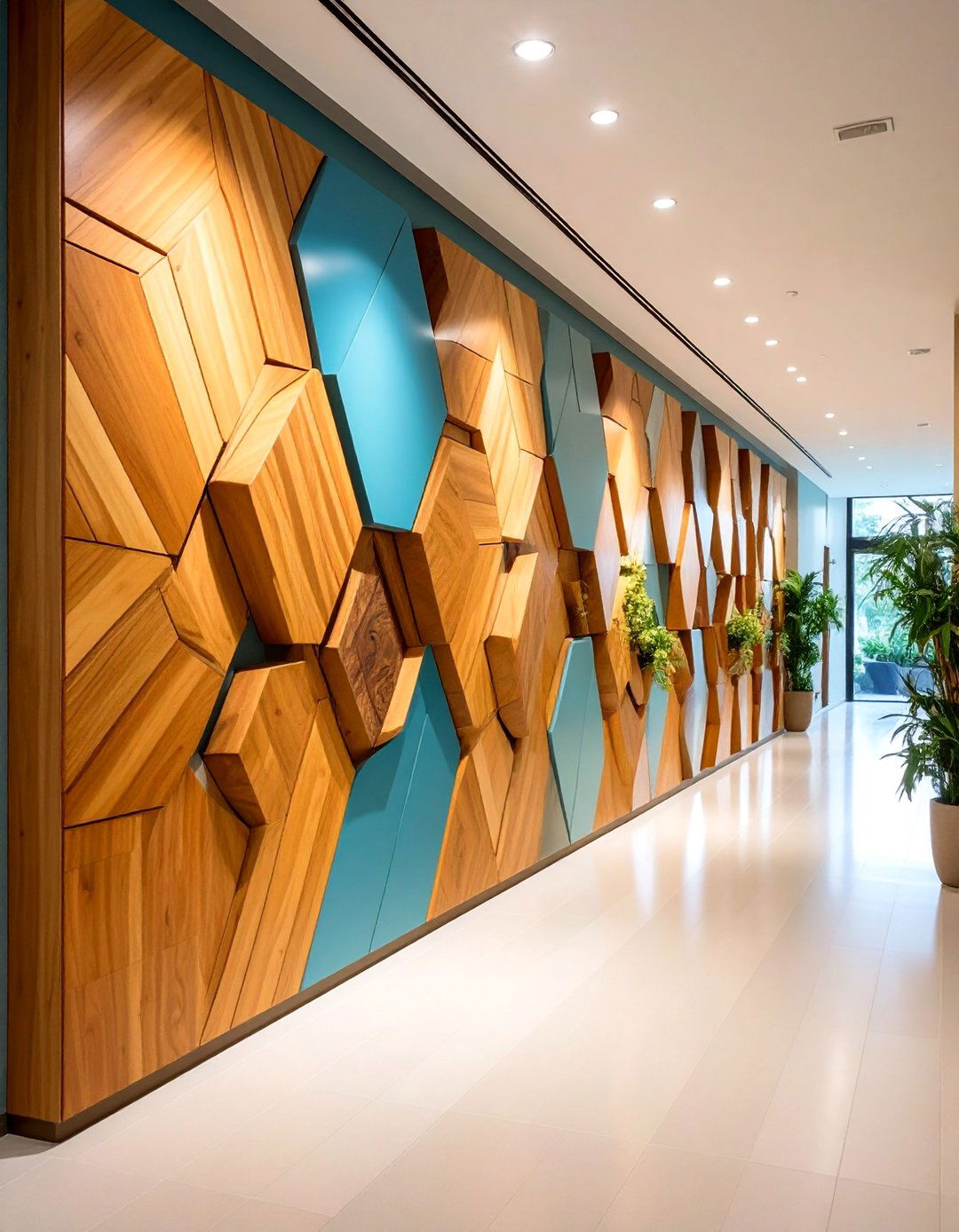
Geometric wood accent walls add modern and stylish touches to hallways, creating dynamic visual interest. Subtle geometric patterns woven into textiles and decor introduce soft contrast enriching overall design. Installation involves precise cutting and arrangement of wooden pieces in repeating patterns like hexagons, triangles, or chevrons. Natural texture through geometric design achieves elegant and refined aesthetics. Wood staining creates color variations within single installations for added depth and dimension. Mixed wood species provide natural color variations for one-of-a-kind artistic appearances. Unique patterns create eye-catching backdrops perfect for living rooms without overpowering spaces. Mounting systems require secure wall anchoring to support concentrated weight loads. Textural treatments add light reflection and architectural interest to back walls.
23. Wood Slat Headboard Feature
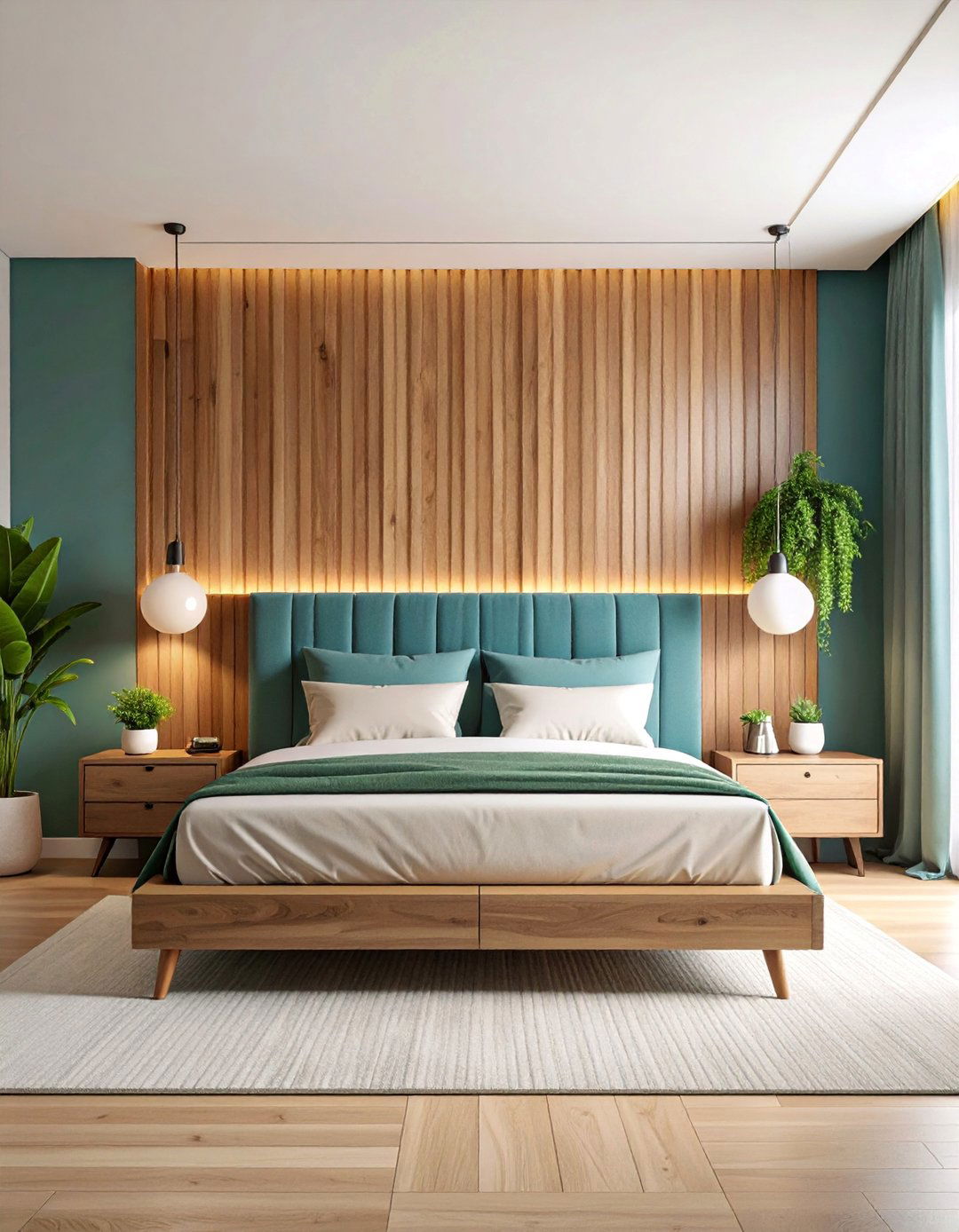
Floor-to-ceiling wood slats behind beds create modern, sophisticated looks using vertical lines for height emphasis. Minimalist bedside drawer units meld with wooden headboard designs for integrated storage solutions. Installation extends from floor to ceiling for dramatic impact that makes rooms appear taller and more spacious. Vertical wooden planks add modern warmth while drawing curious attention from room corners. Wood stain matching between accent walls and bedroom furniture creates cohesive, unified aesthetics. Integrated bedside storage units provide functional convenience within headboard designs. Lighting integration includes LED strips or swing-arm reading lamps for task illumination. Clean lines and unadorned surfaces characterize furniture contributing to order and tranquility. Spacing between slats affects both visual appeal and acoustic properties.
24. Open Wooden Shelving Display
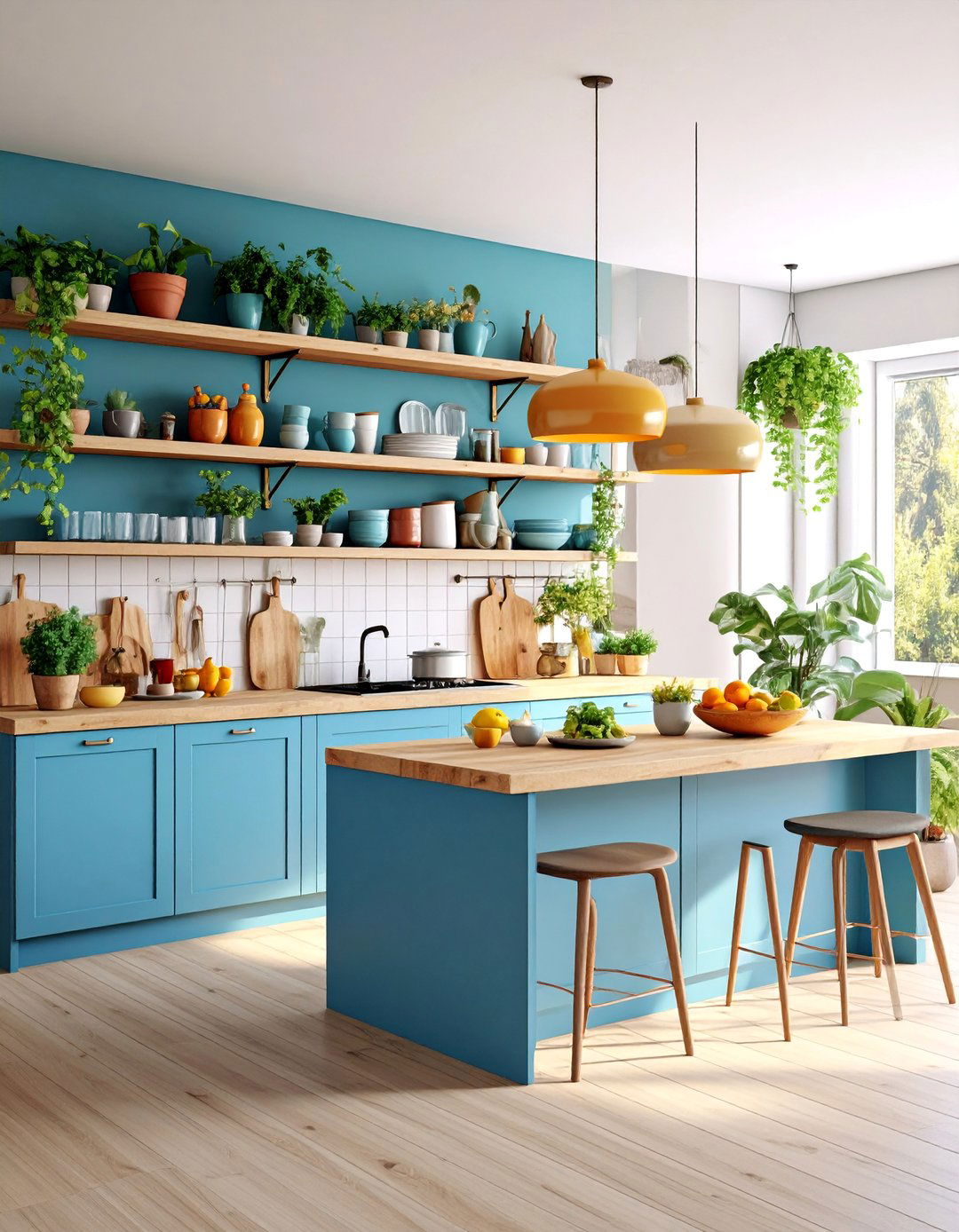
Open shelving showcases belongings while treating displays like bookshelves with grouped similar items. Raw-edge timber floating shelves merge functionality with natural farmhouse elements for contemporary design. Light wood shelving flanking range hoods imitates custom pendants for cohesive kitchen design. Display arrangements follow design principles using odd numbers and varied heights for visual interest. Open shelving offers customization opportunities with shiplap or wallpaper backgrounds. Arched niches displaying potted herbs and treasured decor add character while softening kitchen designs. Wood shelves coordinate with liquor bottle displays for rustic bar area ambience. Clear canisters and arrangements of threes create maximalist yet personalized vibes. Maintenance requires regular dusting and occasional rearrangement.
25. Mixed Wood Tone Interior Scheme
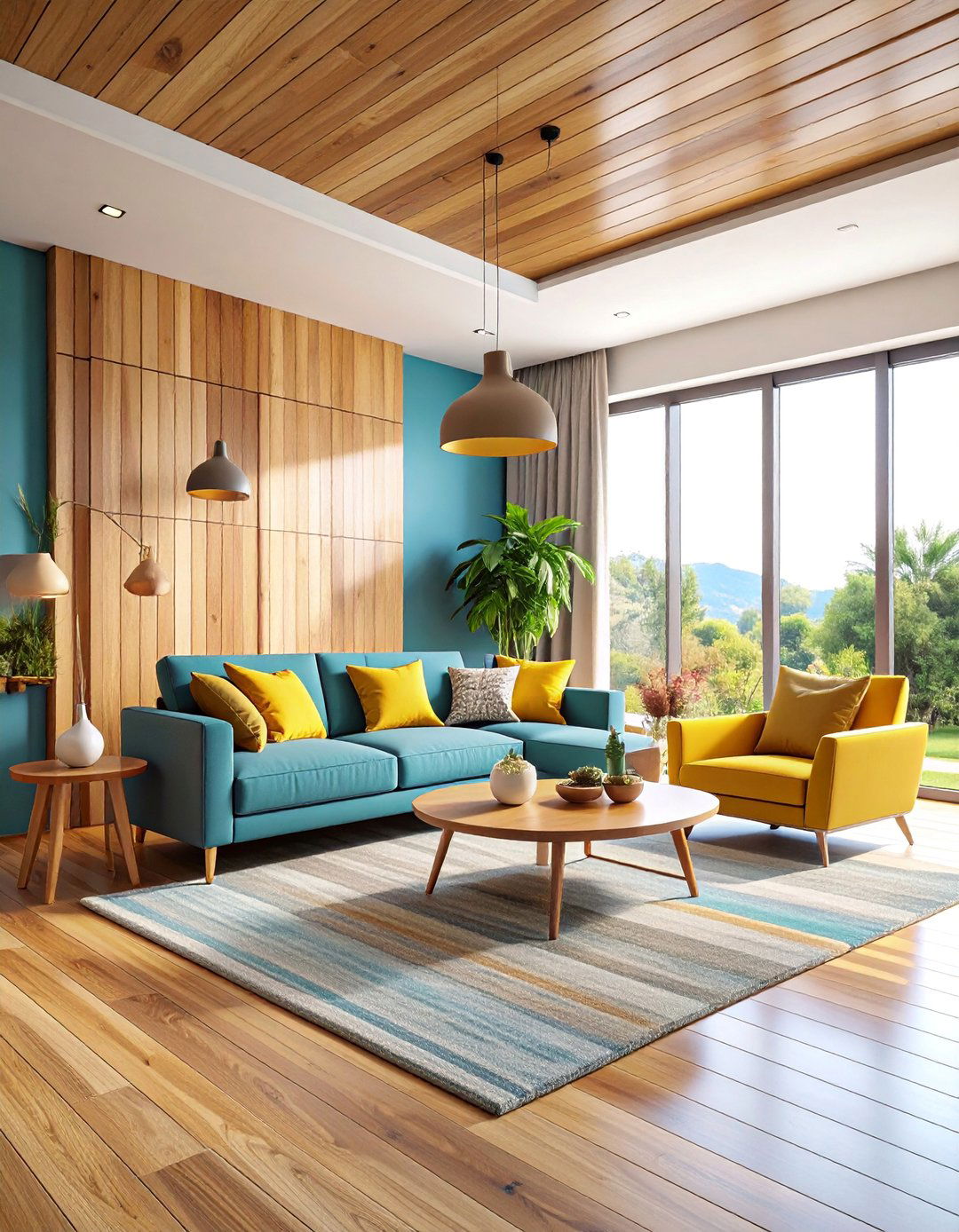
Different wood products available create mixed wood accent designs ensuring one-of-a-kind artistic looks. Japanese interiors showcase darker wood shades while Scandinavian designs prefer lighter tones, creating fusion opportunities. Mid-tone woods like ash, beech, walnut, and oak blend neutral color schemes without fading into backgrounds. Vermont Moonlight Medley wood products mix different boards for engaging office and home spaces. Successful combinations require understanding wood undertones and grain patterns to achieve harmony rather than conflict. Warm wood finishes create grounded feelings that resonate with contemporary lifestyles. Quality craftsmanship combines carefully selected objects maintaining design philosophy balance. Color coordination involves selecting dominant and accent wood tones that complement rather than compete. Coastal collage reclaimed wood combines light hardwoods with rustic textured surfaces.
Conclusion:
Wooden interior design offers limitless possibilities for creating spaces that balance natural beauty with functional sophistication. Current trends emphasize warmer wood tones and darker finishes that bring depth and refined richness to contemporary interiors. Whether incorporating dramatic ceiling beams, sleek built-in storage, or statement furniture pieces, wood remains a cornerstone material that transcends passing fads. Full wood elegance creates environments that resonate on deeper levels, fostering well-being and serenity. From minimalist Japandi aesthetics to bold rustic statements, these 25 design concepts demonstrate wood's versatility in creating personalized sanctuaries that celebrate craftsmanship, sustainability, and timeless appeal for modern living.


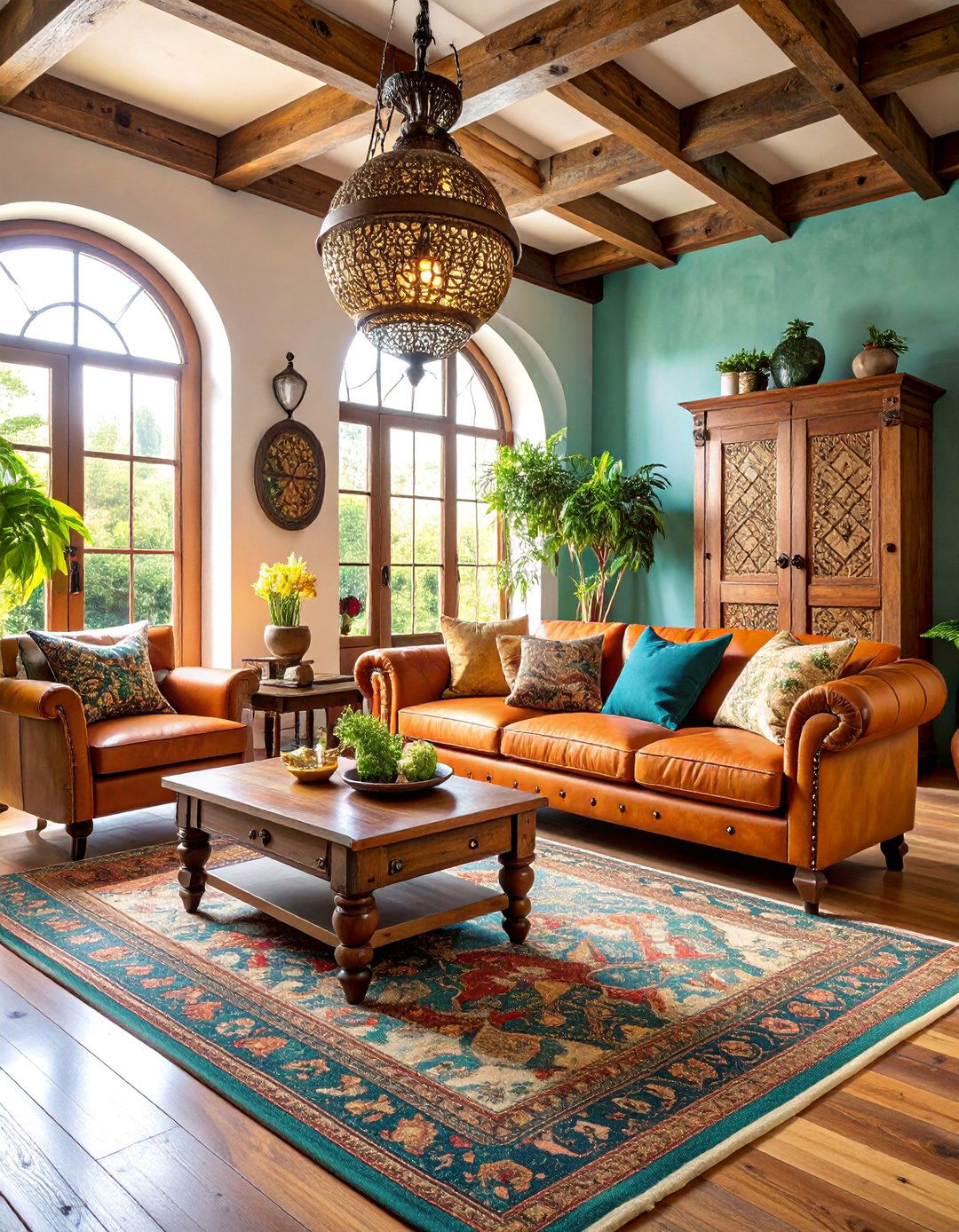
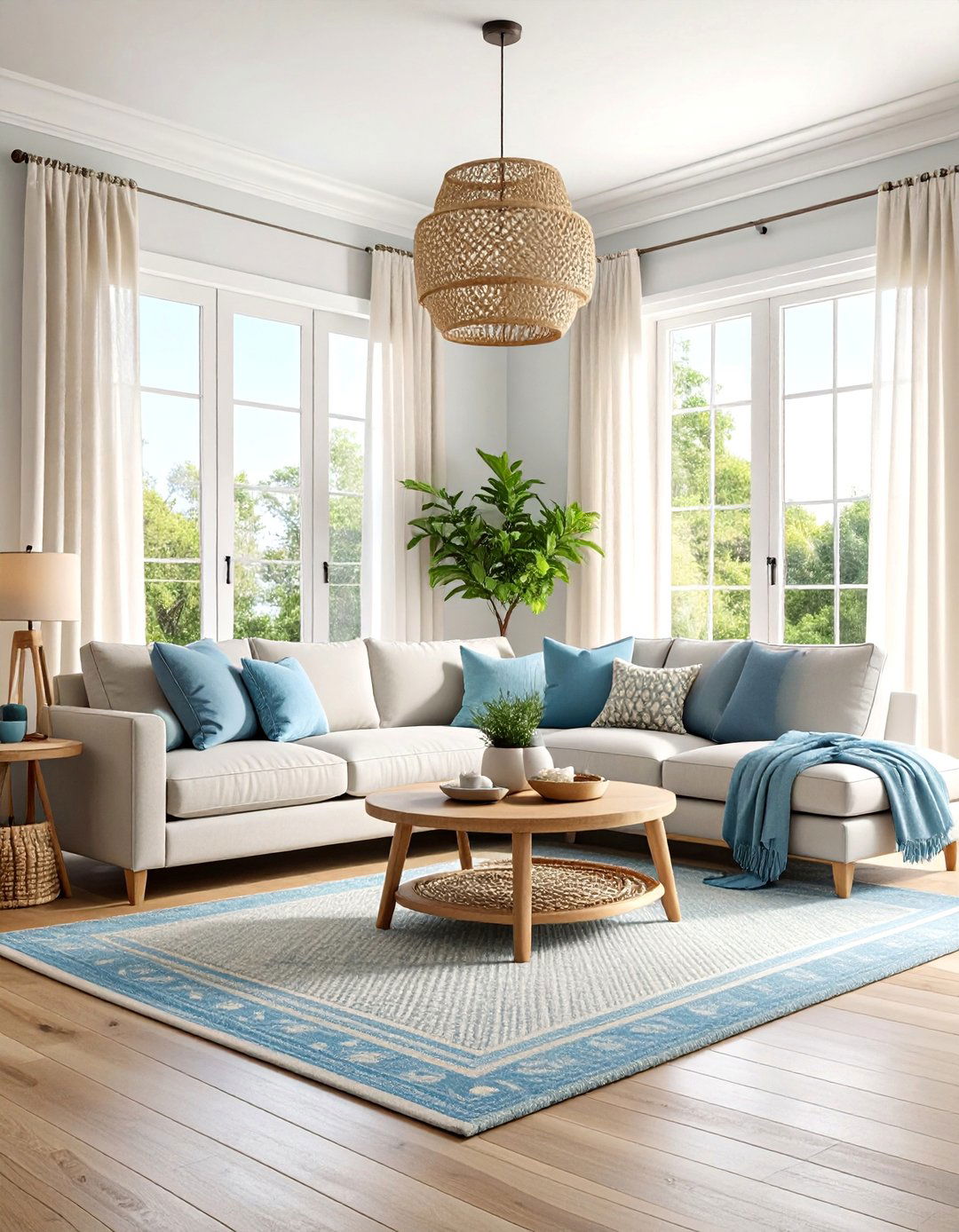
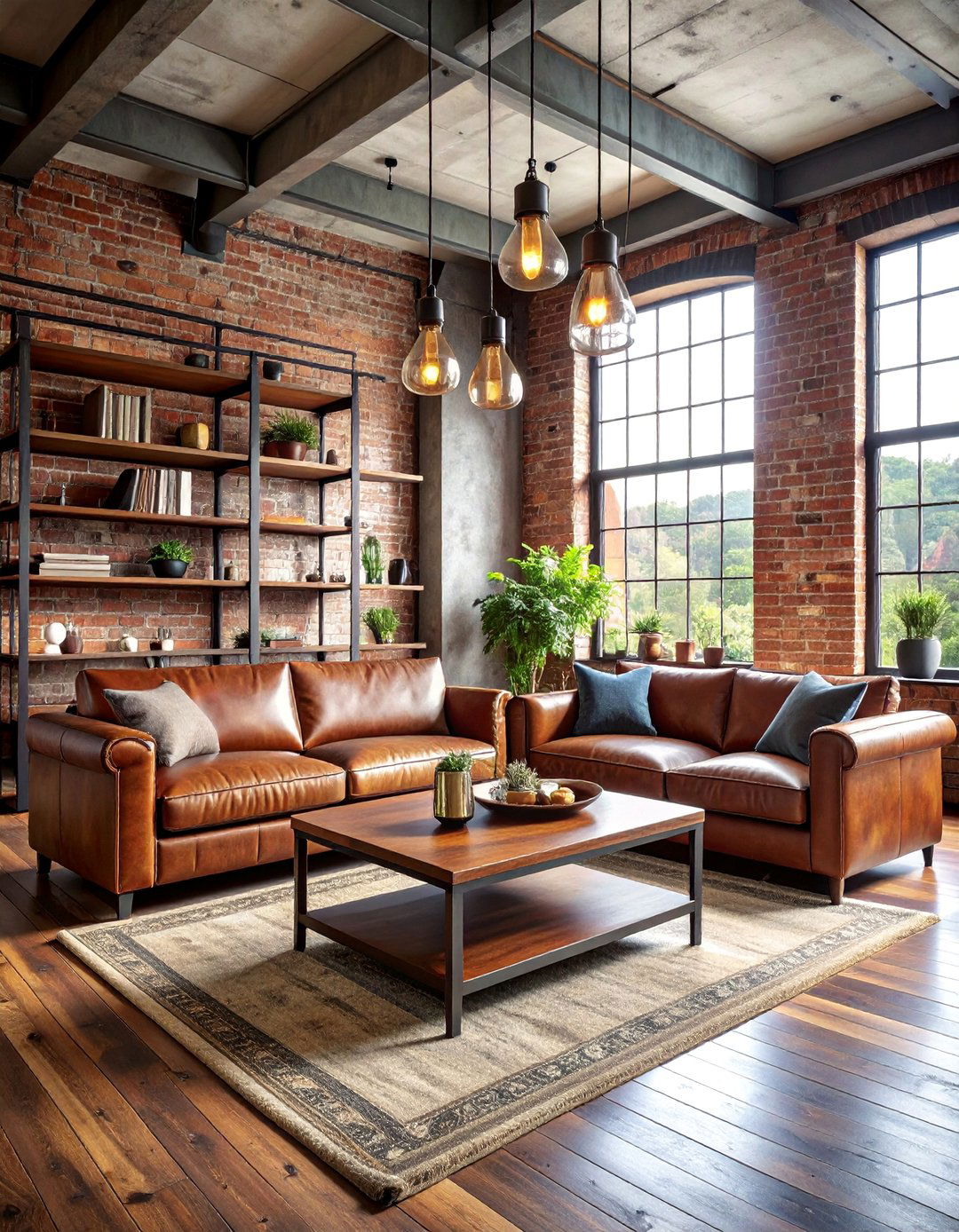





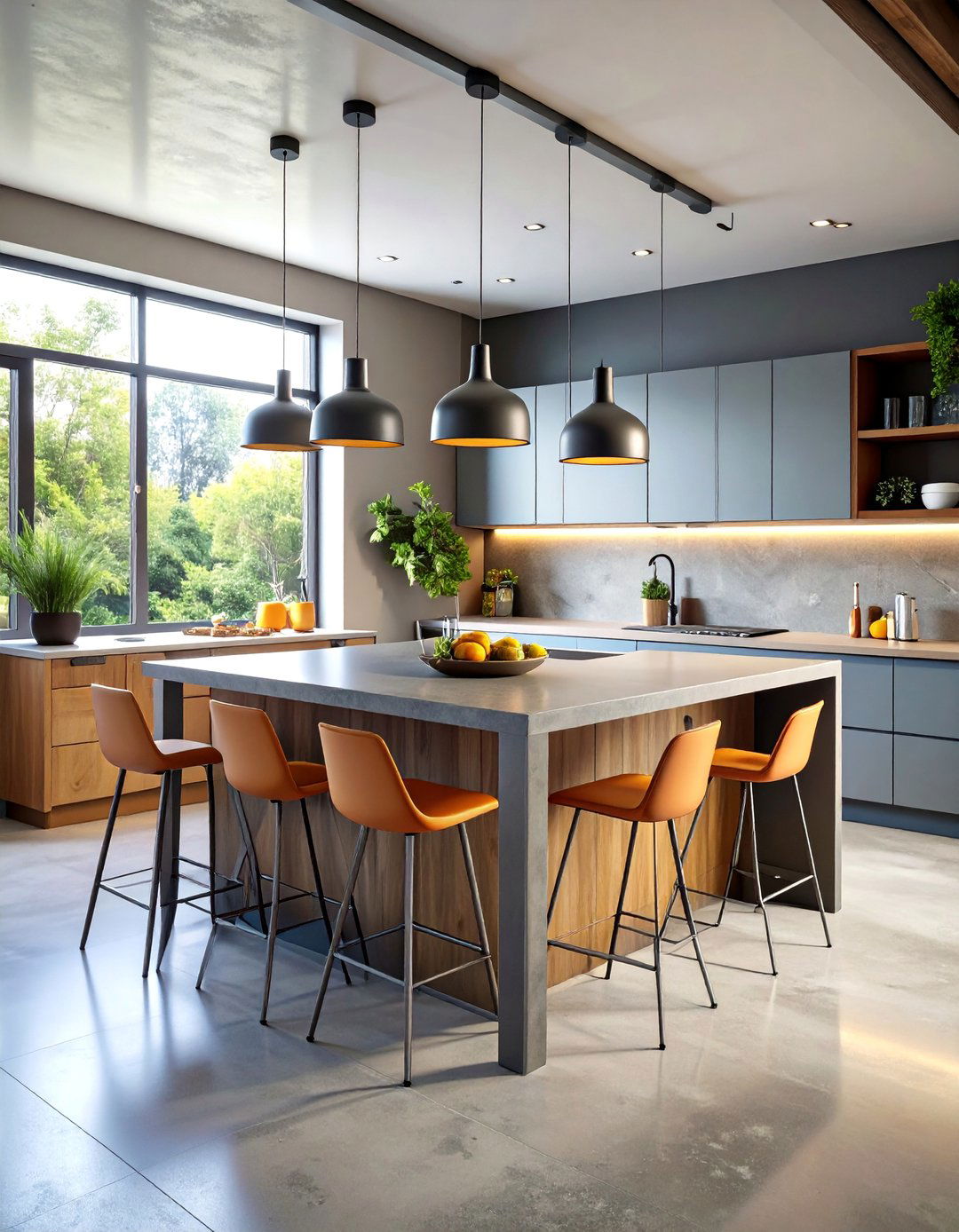






Leave a Reply